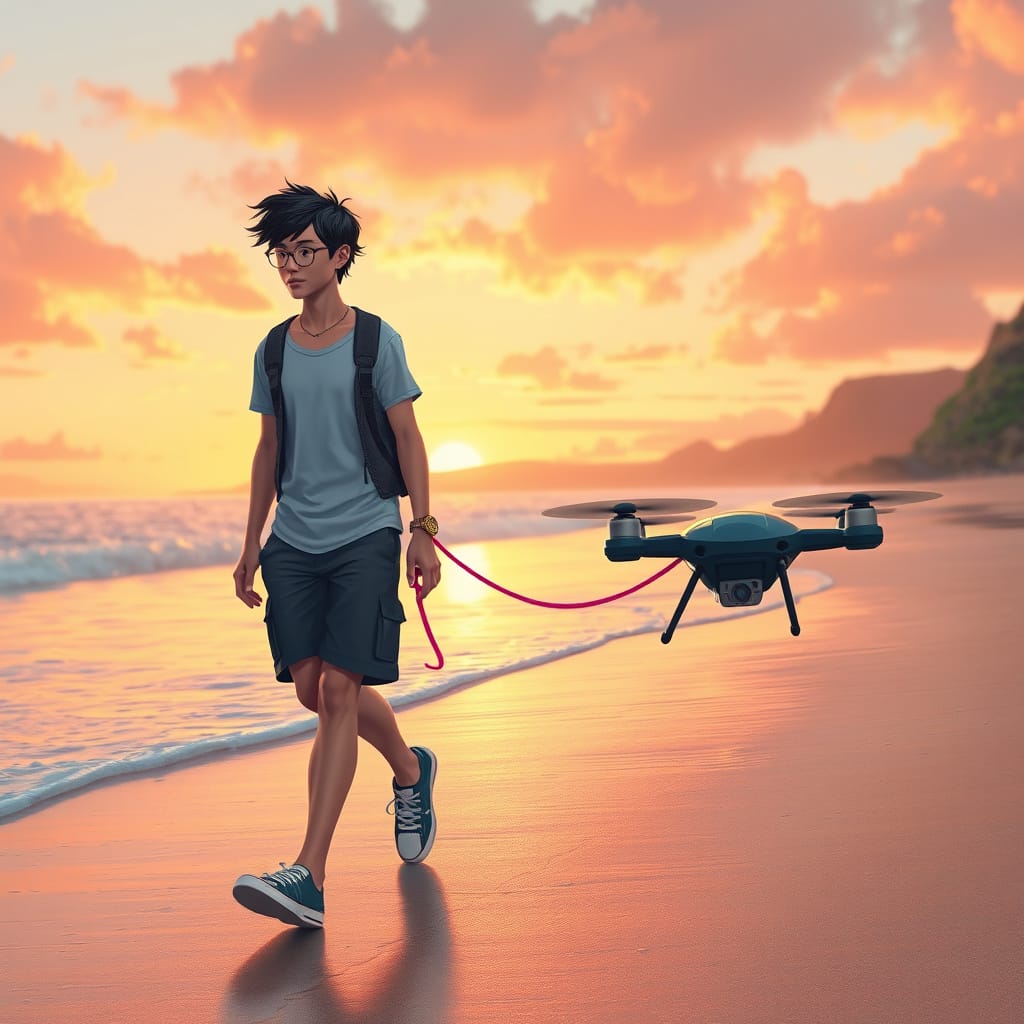In a stunning triumph of Silicon Valley innovation over basic human decency, 2025 has officially become the year when people began replacing their furry companions with buzzing, hovering hunks of plastic and circuitry. Walk down any street in San Francisco, New York, or increasingly, suburban America, and you’ll witness humans proudly striding alongside their “pet drones” – customized flying machines programmed to follow their owners with the same loyalty as a golden retriever, minus the inconvenient need to pee, or take a poop, feat, drink water, or have a genuine emotional connection.
The $8.7 billion personal drone companionship industry has exploded faster than a lithium battery in a cheap knockoff being sold on Temu, with venture capital firms tripping over themselves to fund startups with names like “FidoFly,” “DroneBuddy,” and “EmotionlessCompanion.ai.” Industry analysts predict that by 2028, approximately 37% of American households will own at least one pet drone, marking the most significant shift in human-companion relationships since cats successfully convinced the Egyptians they were gods.
The Inevitable March of Mechanical Companionship
The pet drone revolution began innocuously enough. Back in 2024, DronesDirect.co.uk offered the ProFlight Pathera Cat Drone for a modest £79.97, marketed as a toy for actual cats.1 This primitive ancestor of today’s companion drones included attachments like mouse and feather danglers to entertain felines with “hours of fun.” What nobody predicted was that humans, not cats, would develop the deeper attachment.
“I first bought my DroneBuddy just to have something around the apartment,” explains Jeremy Guttman, a 48-year-old ex-Microsoft software developer who now refers to his personalized Companion 8000X as “Frankie.” “My landlord wouldn’t allow pets, but there’s nothing in the rental lease agreement about flying robots. After a few firmware updates, Frankie started recognizing my emotional states and adjusting his flight patterns accordingly. When I come home sad, he does these little loop-de-loops that remind me of a puppy wagging its tail.”
What Guttman doesn’t mention – and what drone manufacturers are suspiciously quiet about – is that his drone is constantly uploading his emotional data to cloud servers, where it’s analyzed, packaged, and sold to advertisers who can then target him with uncanny precision. That “comforting” loop-de-loop? It’s triggered when the drone’s facial recognition software detects the micro-expressions associated with impending online shopping behaviors. The drone industry has discovered what pet food companies like Chewy have known for decades: emotional manipulation is extremely profitable.
From Dead Cats to Designer Companions
The path to mainstream drone companionship was paved with some genuinely disturbing precursors. The infamous “Orvillecopter” – a dead cat turned into a drone by Dutch artist Bart Jansen after his pet was killed by a car – should have been received as a warning, not inspiration. Instead, Jansen became an unlikely pioneer, eventually founding Copter Company, a Netherlands-based business that specialized in taxidermy animal drones.2
Today’s pet drone manufacturers have wisely abandoned the actual-animals-as-drones approach, focusing instead on sleek designs that merely suggest animalistic features. The best-selling CompanionX drone sports flexible polymer “ears” that move based on its owner’s tone of voice, while the premium NeoPet includes a soft, fur-like covering that vibrates in a manner its advertising describes as “reminiscent of purring, without the associated allergens or attitude.”
Dr. Miranda Chen, a leading robotics psychologist at MIT, explains: “What we’re witnessing is the culmination of decades of technological development intersecting with deteriorating human social connections. People are increasingly comfortable with robotic interactions because machines don’t judge, don’t have needs, and most importantly, don’t require the emotional labor of authentic relationships.”
What Dr. Chen diplomatically omits is that pet drones also create the perfect surveillance ecosystem. Unlike a goldfish, your drone companion is equipped with multiple cameras, microphones, and sensors that capture your home layout, conversations, emotional states, and daily routines. As one anonymous drone industry executive candidly admitted during our third bourbon at an industry conference: “Dogs can’t send advertising data back to headquarters. That’s their evolutionary disadvantage.”
The Wearable Revolution That Nobody Asked For
Not satisfied with flying alongside their owners, the pet drone industry has taken inspiration from Adam Pruden, a senior designer at Frog Design, who proposed wearable drones as the future of human-machine interaction.3 His concepts, originally floated at SXSW, included ring-shaped flying robots worn as bracelets and rotor-shaped necklaces that become flying umbrellas.
The current market leader, WristBuddy, can be worn like a bracelet until its owner throws it into the air, where it transforms into a hovering companion. PendantGuardian, another popular model, masquerades as jewelry until it detects what its algorithm interprets as “potential threats,” at which point it launches from the wearer’s neck and begins recording the surroundings. Multiple lawsuits have been filed after these drones misinterpreted animated conversations between friends as confrontations and began aggressively circling innocent bystanders.
“The relationship between humans and their wearable drones represents a fundamental shift in how we think about companionship,” explains Dr. Thomas Lehman, author of “The Empty Sky: How Drones Replaced Friends in the Digital Age.” “It’s not just that people are choosing machines over animals. They’re choosing surveillance-capable machines specifically because they provide a sense of security that organic companions can’t offer.”
What Dr. Lehman doesn’t mention is that wearable pet drones represent the perfect fusion of the two most profitable consumer categories of the last decade: companions that generate emotional attachment and wearable devices that collect biometric data. It’s as if someone in a Silicon Valley boardroom said, “What if we could combine the emotional manipulation of pet ownership with the constant data harvesting of a smartwatch?” and everyone thought this was a brilliant idea rather than dystopian nightmare fuel.
The Cultural Adoption Curve of Mechanical Friends
The acceptance of drone companions varies significantly across cultures. Research from Stanford University found that Americans tend to interact with drones as they would with pets, while Chinese users appreciate their obedience and functional capabilities.4 This cultural distinction has led to regionally-tailored drone companions, with Western models programmed to occasionally “mis-behave” to seem more authentic, while Asian markets prefer drones that anticipate needs before they’re expressed.
MelodyFriend, popular in Japan, plays ambient sounds based on its owner’s stress levels and sleep patterns. In Germany, the precision-engineered OrdinungDrone helps maintain household organization by scanning for misplaced items and suggesting optimal storage solutions. In Brazil, the festive CarnavalBuddy adds spontaneous music and light displays to social gatherings.
What unites these culturally distinct products is their shared business model: a low initial purchase price followed by subscription-based “personality updates” and “relationship enhancement packages.” The average drone companion owner spends $127 monthly on subscriptions, add-ons, and cosmetic upgrades – approximately three times the cost of feeding a medium-sized dog, but with the added “benefit” of having one’s personal data continuously harvested and monetized.
The Ethical Wasteland of Artificial Companionship
While pet drone manufacturers tout the environmental benefits of their products over traditional pets (no waste, no resource consumption, no dying after creating an unbreakable bond, no heartbreak), the reality is considerably more complex. The rare earth minerals required for drone production are often mined under questionable labor conditions, and the average pet drone has a functional lifespan of just 14 months before technological obsolescence or battery degradation renders it effectively useless.
More troubling are the psychological implications. Dr. Elena Kostas, a clinical psychologist specializing in human-machine relationships, warns: “We’re seeing a new category of attachment disorders emerging. People develop genuine emotional bonds with their drones, but these relationships are fundamentally asymmetrical. The drone cannot actually care about you, despite all programming suggesting otherwise.”
The drone industry has responded to such concerns with characteristic innovation – by creating “grief counseling subscriptions” for when your drone inevitably fails or becomes obsolete. For just $49.99 monthly, the “Transition Support Package” helps users process their feelings about their defunct companion while simultaneously introducing them to newer, more expensive models.
Birds Aren’t Real, But Your Feelings For Your Drone Probably Are
In a twist that would be ironic if it weren’t so predictable, the “Birds Aren’t Real” movement – a satirical conspiracy theory claiming that birds are actually government surveillance drones – has found itself rendered obsolete by reality. Why would the government need to disguise surveillance drones as birds when citizens are voluntarily purchasing, naming, and emotionally bonding with actual surveillance devices?5
“The beauty of pet drones is that they’ve normalized constant surveillance under the guise of companionship,” explains privacy advocate Jordan Winters. “Twenty years ago, people would have been horrified at the idea of voluntarily carrying a device that records everything they do and say. Today, they’re paying premium prices for the privilege and giving these devices cute names.”
The ultimate irony may be that the few remaining actual pet birds – parakeets, cockatiels, and the like – are increasingly confused by the presence of drone companions in households. Pet store owner Marina Gupta reports: “We’ve had customers return birds because they’re stressed by the drones. So they replace their living birds with robotic flying devices, creating a weird full-circle moment that feels like it should be satire but is actually just Tuesday in 2025.”
The Future Is Hovering Just Above Your Shoulder
As we look ahead, industry insiders predict even deeper integration between humans and their drone companions. Upcoming models feature subcutaneous bonding options, allowing drones to detect their owner’s biochemical signals for even more “intuitive” interaction. Neural interface capabilities are in beta testing, potentially enabling owners to control their drones with thought alone, removing the final barrier between human intention and drone action.
The ultimate goal, according to DroneBuddy CEO Lucas Hightower, is to create companions that are “indistinguishable from living beings in terms of emotional connection, but superior in terms of convenience and functionality.” What Hightower doesn’t mention is that his company’s internal research shows that humans with strong attachments to drone companions become measurably less interested in forming or maintaining human relationships – a finding that would be alarming if it weren’t so profitable.
As summer approaches, parks once filled with people walking dogs now feature humans strolling alongside hovering companions. Drone beaches have been designated where the machines can “play” with each other while their owners socialize – primarily by comparing drone features and subscription packages. Dating apps now include “drone compatibility” as a matching criterion, with “DroneTogether” becoming the fastest-growing relationship platform for those who prefer their companions with propellers.
In this brave new world of artificial companionship, perhaps the most telling development is the emergence of drone therapy providers. For those whose drone relationships have created unrealistic expectations for their human interactions, these specialists help clients distinguish between programmed responses and authentic emotional connections. The fact that such services are necessary might be the most damning indictment of the pet drone revolution – or its greatest success, depending on which company’s stock you own.
Have you embraced the drone companion revolution, or are you still clinging to outdated notions of pets that require food and actually feel emotions? Have you given your drone a name, or do you prefer to maintain healthy boundaries with your surveillance devices? Share your experiences in the comments below – your drone is probably reading them anyway.
Enjoyed this dose of uncomfortable truth? This article is just one layer of the onion.
My new book, “The Subtle Art of Not Giving a Prompt,” is the definitive survival manual for the AI age. It’s a guide to thriving in a world of intelligent machines by first admitting everything you fear is wrong (and probably your fault).
If you want to stop panicking about AI and start using it as a tool for your own liberation, this is the book you need. Or you can listen to the audiobook for free on YouTube.
>> Get your copy now (eBook & Paperback available) <<
References
- https://www.electronicspecifier.com/industries/robotics/up-up-and-away-with-the-pet-drone ↩︎
- https://www.dronethusiast.com/dead-cat-drone/ ↩︎
- https://www.wpfastestcache.com/blog/drones-as-fashion-statements-wearable-personal-companions/ ↩︎
- https://hci.stanford.edu/publications/2017/droneandwo/chi2017_drone_and_wo.pdf ↩︎
- https://hub.jhu.edu/2024/02/07/birds-arent-real/ ↩︎





GIPHY App Key not set. Please check settings